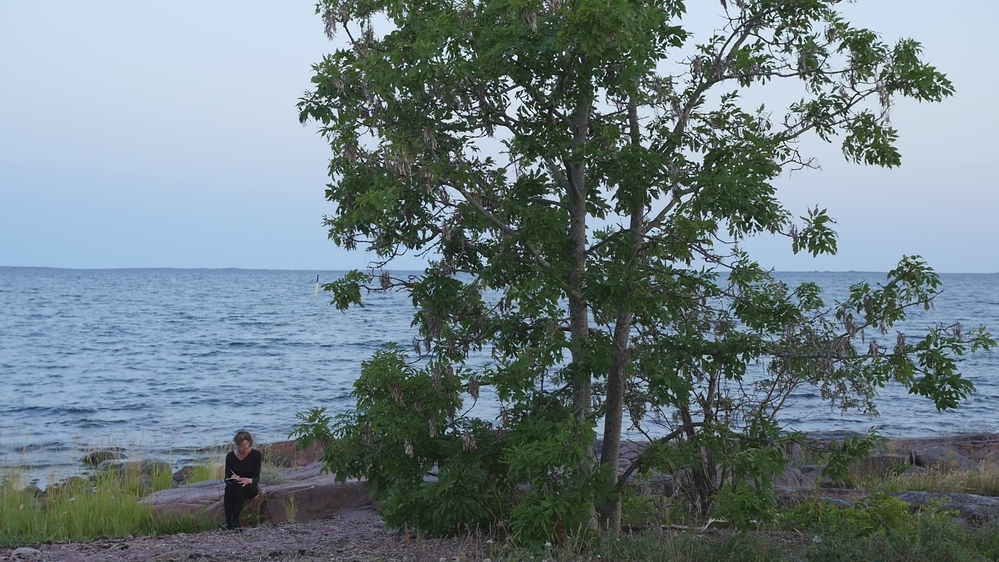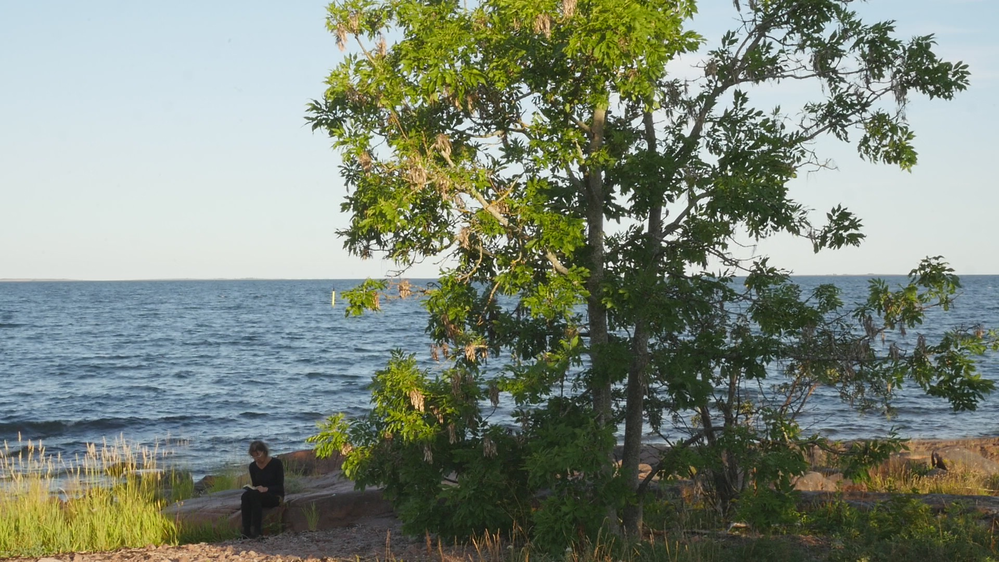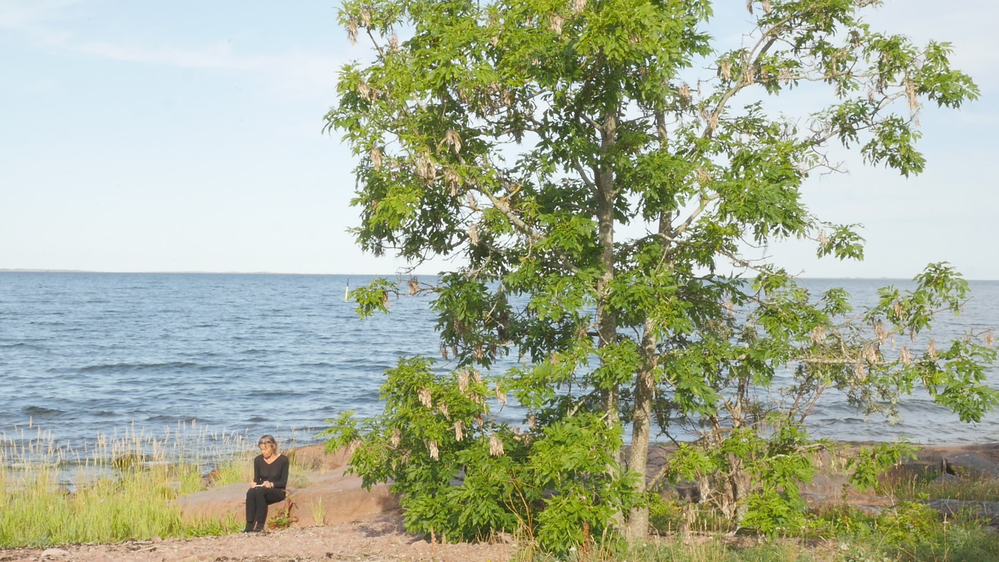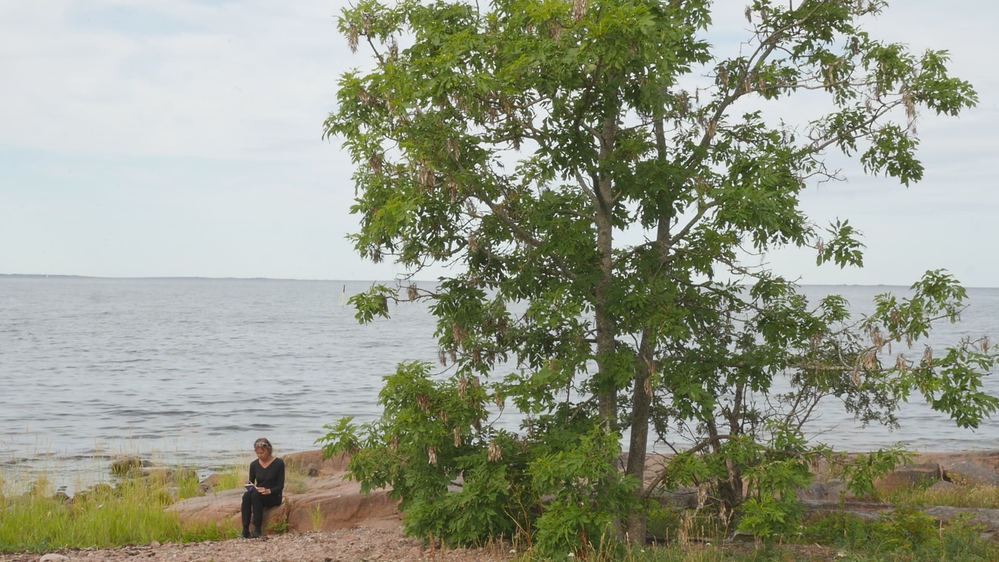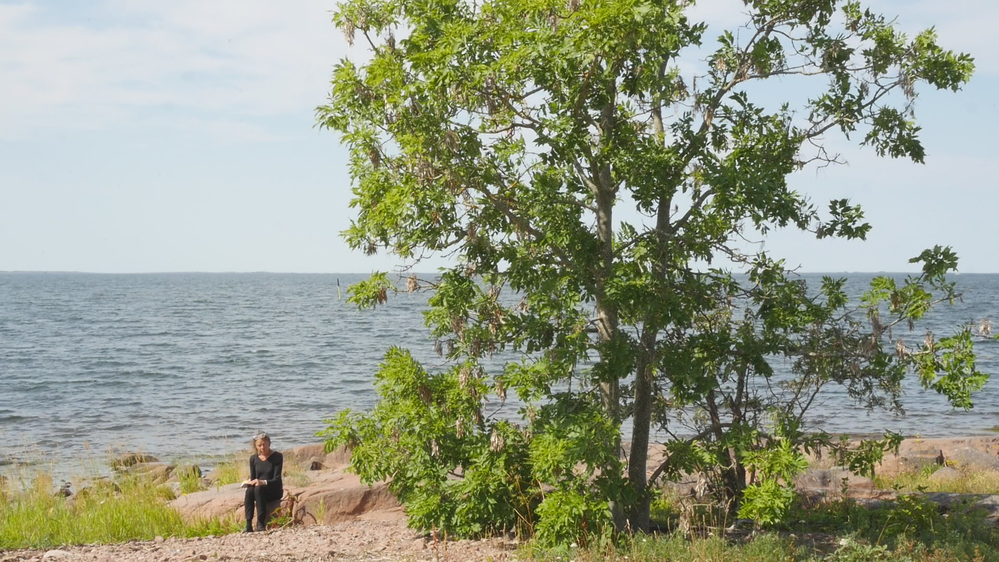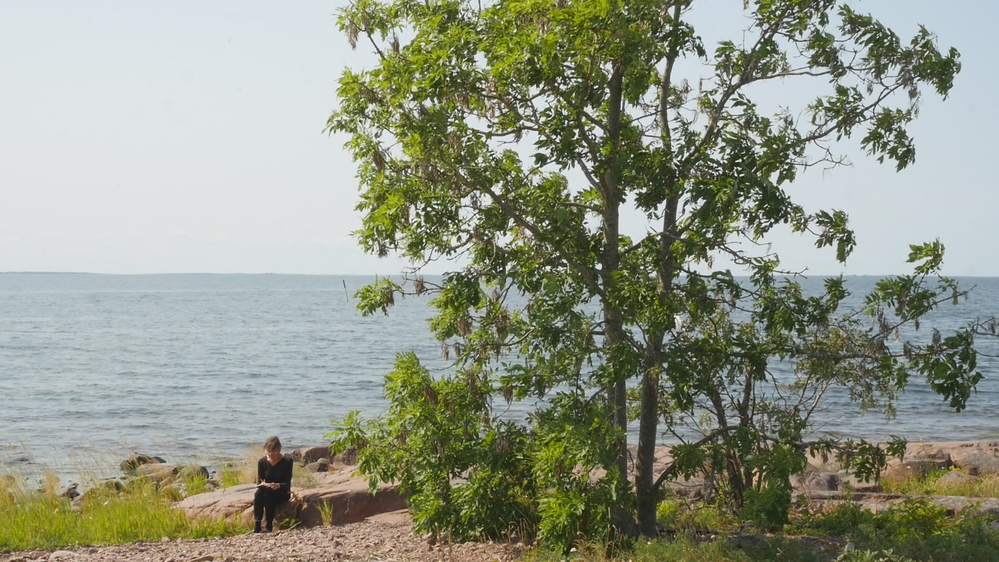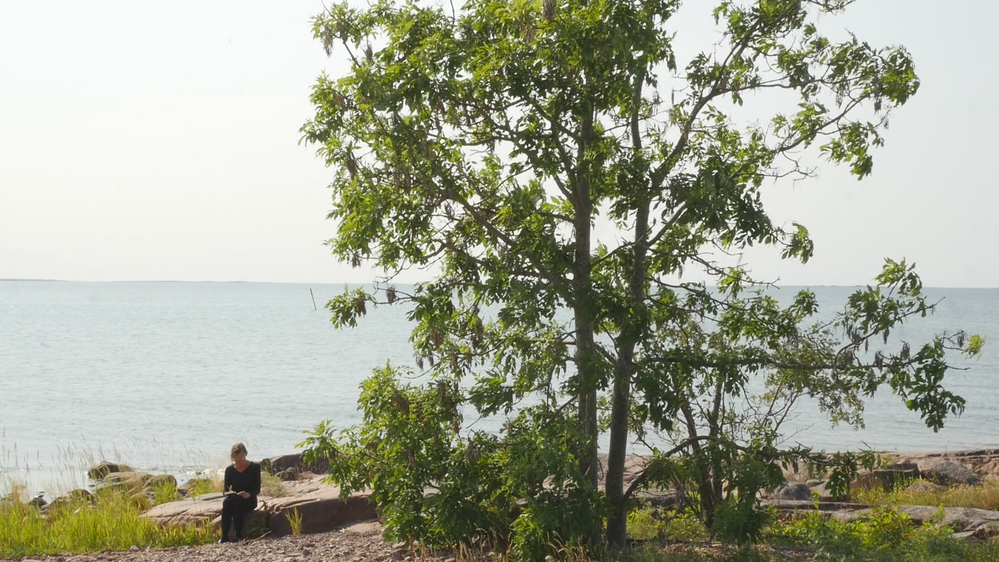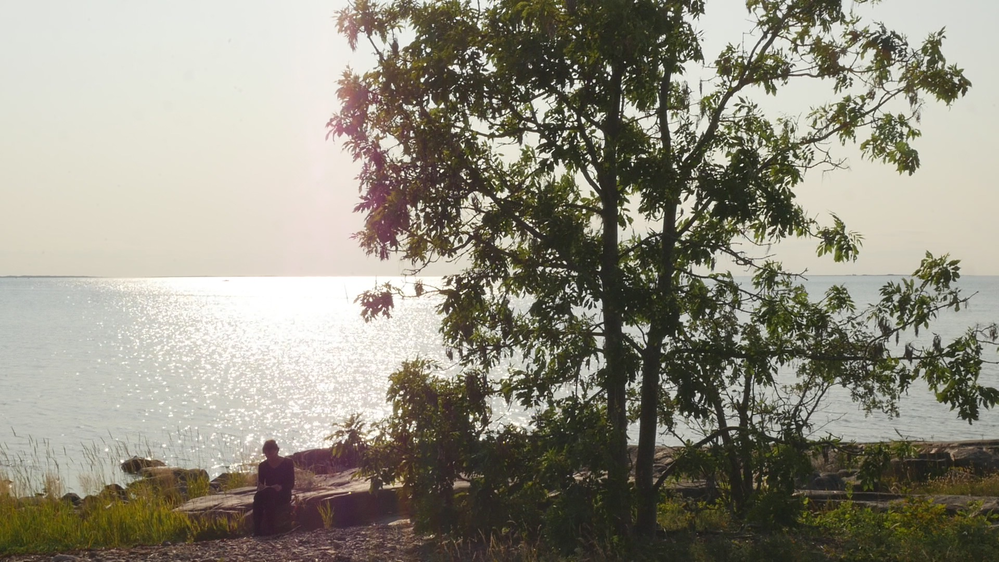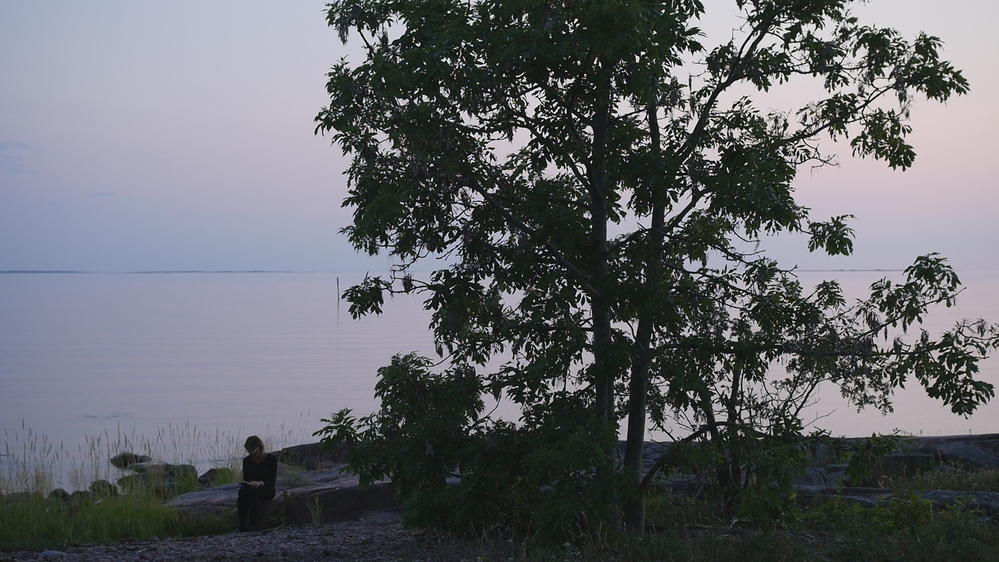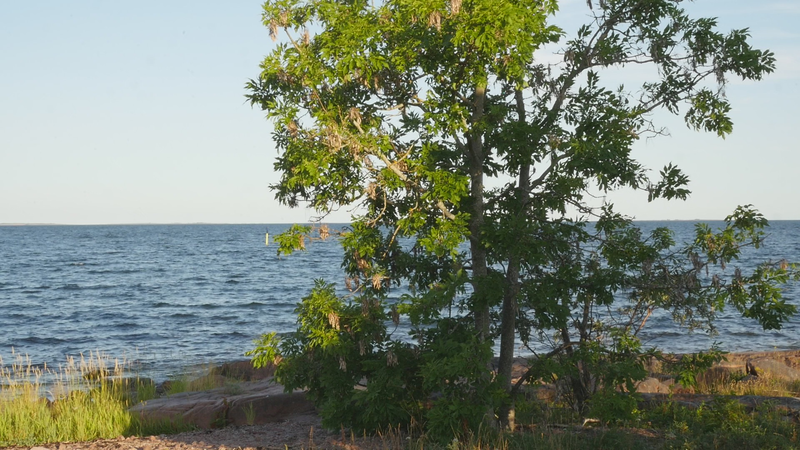Introduction
In this essay I describe one example of working with a tree and suggest that such artistic methods, like performing with a tree repeatedly or addressing a tree in writing as a performance for camera, serve as useful tools to generate material to reflect upon later. The heightened perceptual awareness and the intensity of the moment of performance helps in articulating observations and ideas that might not have come to the fore in other circumstances.
During the artistic research project Meetings with Remarkable and Unremarkable Trees (2020-2021), which I have discussed in Performing and Thinking with Trees (Arlander 2022), I made the acquaintance of a large variety of trees. In this exposition I am presenting one of them, a small ash tree growing on the shore next to the historical post quai on Eckerö on the Åland Islands between Finland and Sweden, where I spent July 2021 in a residency. This tree interesting as an example because I chose to explore with that one tree most of the various approaches I had tried with other trees before. They were all uploaded in the order they were created on one page on the RC, https://www.researchcatalogue.net/view/761326/1307712 which serves as an appendix or archive to this exposition.
The three text-based experiments were exploring different strategies. The first experiment “On vegetal Democracy” (10 min 40 sec) was performed on 7 July 2021, for the event “Perform – Respond – Extend” organized by the Artistic Research Working Group of Performance Studies international (see program http://psi-artistic-research-working-group.blogspot.com/2021/07/artistic-research-working-group-perform.html ). In that experiment I read a previously written text about vegetal democracy, a term coined by philosopher Michael Marder (2013) to the tree, in English, and asked for the tree’s opinion about it. The video is shot from a distance, showing most the tree, while the reading is recorded by a microphone in my hand.
The second experiment “Askträdet på Eckerö – The Ash Tree on Eckerö” (med text – with text) (6 min 11 sec.) was performed on 8 July 2021, the same “Perform – Respond – Extend” event, sitting on the rock next to the tree and shot from a middle distance, showing the leaves of the tree in greater detail. I am writing a letter to the tree, in Swedish, discussing the myth of Daphne, who was transformed into a tree to avoid the harassment by Apollon, and wondering, whether the tree is a human in disguise. The letter is read and recorded as a voice-over and translated into English subtitles added to the video.
The third experiment, “Dagen med Asken – Day with an Ash” (26 min 12 sec) was performed on the 22 July every second hour between 5 am and 11 pm. The text that I write during each session in Swedish is read and recorded as a voice-over narration, and the English translation is added as subtitles, as a rather fast-moving text scroll. Two shorter versions were edited of the same video material, “Day of an Ash” (9 min 50 sec) records a time-lapse image of the ash tree without human presence, while “Day with an Ash (brief)” (12 min) shows one minute of each session with me sitting on the rock next to the ash tree, writing, albeit without text. It is this third experiment and the version with the text that is the center piece of this essay.
I made several experiments without text, exploring various poses and different distances and framings, beginning with Attempting to Become an Ash Tree (5 min) where I perform the two-legged tree pose next to the tree, as I have done with many other trees (see Arlander 2022), continuing with a close up, Listening with an Ash Tree (5 min) and then combining them into two split-screen videos. Another attempt, entering the tree as close as possible, was named Wind Dispersal (With an Ash Tree) (9 min), almost a close-up with the horizon visible through the branches. The name refers to the mode of seed dispersal used by the ash tree. In The Double of an Ash Tree (11 min), performed in the low evening sun, I lie down on the rock next to the tree with my feet up, as if mimicking the two trunks of the ash tree. Later I also made In the Ash Tree (7 min 50 sec), where I enter the image, climb up on the lowest branch of the ash tree standing in the tree close to its trunk, climb down again and exit the image. This action was edited into several versions, Into the Ash Tree, which shows the human entering the image, climbing into the tree, and then slowly disappearing through a slow crossfade, and Out of the Ash Tree (7 min 50 sec), which shows the human appearing in the tree through a slow crossfade, then climbing down and exiting the image. These were not combined, although following the model of previous attempts at appearing and disappearing that could be done.
The material from the day with the ash tree, which I will focus on here, was also edited into several version. Day of an Ash (9 min 50 sec) shows the ash tree without human presence, while Day with an Ash (brief) (12 min) and 11 pm shows me sitting on the rock next to the ash tree, writing. In Dagen med Asken – Day with an Ash (26 min 12 sec) the text that I write in Swedish on each occasion is read and recorded as a voice-over narration added to the video, and the English translation is added as subtitles, a rather fast-moving text scroll.
Like the other methods used in these explorations with the ash tree, the strategy of recording one day with a tree, I have explored with several trees before resulting in works like The Tide in Kan Tiang (2016), Grey Day in Rekdal (2017), Sunday with a Pine (2017), Day with Old Tjikko (2019), Day with a Juniper 1-2 (2019), Day with the Firethorn Rhus(2020), Day with a Bog Birch (2020), Day with a Pine (2020), Another Day with a Pine (2020). These works were preceded by a series of days and nights, that is, a full 24 hour related to Animal Years (2003-2015) and to visits to Kilpisjärvi in the high north (Day and Night with Malla 2014 and Day and Night with a Mountain Birch 2021). Most of these works contain my diary notes written after each session. What was new in the day with the ash tree was incorporating writing into the image, recording the act of writing, something I had previously done only in one-off sessions like Dear Olive Tree and other letters to trees.
The diary written during a day with a tree combined with a rough time-lapse video of that action can exemplify one possible artistic strategy, one method of generating data, to use the terminology of social scientists, one way of producing material for artworks, for reflection, for research.
The video
Dagen med Asken - Day with an Ash (26 min 12 sec) 2021
the original text narrated in Swedish is translated into subtitles in English.
Reflection
It is worth remembering that this journal was written there and then, without any real editing afterwards, and could thus also be considered the record or documentation of a performance. Moreover, the text was written in Swedish, and translated into English the following day, which means that some expressions seem rather awkward or do not fully reflect the mood of the original text. It is nevertheless rather fascinating to note that I felt the need to have some facts or ‘content’ to write about and used some of the time between sessions to read about ash trees online. There is a subtle balance between descriptions of the weather and notes of changes in activities during the day and stories or literature about matters related to ash trees that I had come across before the session at hand. Writing is an aid that enhances observation at the same time as this kind of semiautomatic or associative writing also generates ideas and forces one to leave self-criticism to the side. Thus, by way of a conclusion of sorts, one can argue that such artistic methods, like performing with a tree repeatedly or addressing a tree in writing as a performance for camera, serve as useful tools to generate material to reflect upon later. The heightened perceptual awareness and the intensity of the moment of performance helps in articulating observations and ideas that might not have come to the fore in other circumstances. How and for what purpose one chooses to use those observations and ideas is another matter.
References
Arlander, Annette (2020-2021) Meetings with Remarkable and Unremarkable Trees. Project blog https://meetingswithtrees.com Project archive https://www.researchcatalogue.net/view/761326/761327
Arlander, Annette. 2022. “Becoming a Tree with a Tree.” Journal of Dance & Somatic Practices Vol. 14 Number 2 2022, 231-248. https://doi.org/10.1386/jdsp_00081_1
Arlander, Annette. 2023. Performing and Thinking with Trees, Art theoretical writings from the Academy of Fine Art 15 (University of the Arts Helsinki) https://urn.fi/URN:ISBN:978-952-353-431-5
The Journal
In the following account still-images from the video are placed next to the text fragments, (with the original texts in Swedish to the right) to indicate the passing of time:
Eckerö Post Quay 22.7.2021 5 am in the morning, or 4.59 to be exact. Time to begin the day with you, dear ash tree, at sunrise. I shall sit with you every other hour and follow how the light changes, how the wind shifts or not, how people come and go. And how you are doing standing where you do. I have posed with you for the camera several times and thought I would now try out this diary form to see if I could learn something new of you, from you, with you in this way. I hope you do not mind and remain as benevolent and generous as before. Behind you I can see the horizon is already turning orange, although the sun is behind the trees. The wind blows from southwest, from the sea, the day begins with waves lapping and silence. A good morning for you as well, I suppose. Thus, simply: Good morning!
Now it is seven o’clock and the sun is high in the sky, the wind has shifted from south to west. I can see it from the waves and also the flag on the quay. The sun shines on some of your branches but does not reach me sitting here on the rock in your shade. I wonder if you can feel the warmth of the sun or is it only the light you care for, because that is what you use in your photosynthesis. It is still cold, or chilly, at least compared with the heat wave in recent weeks. And it is still dry. I assume your roots stretch deep into the ground, while your leaves are large and fresh. The seeds, however, are completely dry and likewise some of last year’s leaves. Evidently you invest in making seeds only some years. Why they remain hanging dry on your branches I don’t understand; should not the wind have carried them out wandering or simply spread them around? It seems like you have kept them for yourself. Why? Most of the ashes I have seen do not have last year’s seeds hanging on their branches. This is something you have invented on your own, it seems. Or then there is a reason that I simply don’t understand. Sorry for being such a “besserwisser”, I must assume that you know what you are doing with your own offspring.
The sun is warming, the wind has abated, it is nine am. The sea is blue behind me, the sky is blue with white stripes of clouds. The first tourist cars are parking on the post quay. The waves are lapping like before, while the flag shows me that the wind is no longer blowing. – I read on the internet about ash trees and found out to my surprise that you are endangered in Sweden and in many parts of Europe. The reason is some kind of fungal disease that kills ashes. Fortunately, it has not affected you nor the other ashes in the area. On the contrary, you all seem very safe and sound and green. I also read that you are actually of the same family as lilacs, which seems slightly absurd. I cannot think of one trait in common, whether in appearance or mode of growth. Although family relations can be strange at times. Ashes are not very common in the Helsinki area and higher up near Hämeenlinna they hardly exist at all. In my childhood experiences ashes belong to Lubondas, in the archipelago between Porvoo and Loviisa, and later in other places on the coast. I once brought with me two ash plants from Kökar and planted them in Koivumäki, near Hämeenlinna. One of them survived and is now a tall tree, not as tall as you, but almost. Funny to call you a tall tree, because compared to ashes in general you are rather small, and probably fairly young as well. Although, let’s not talk about age …
It’s eleven am and the sky is partly covered by clouds, the sea is not as blue as before and now the waves have calmed despite the wind rising slightly – the sea always comes a bit later. Now there are more cars in the parking lot and both of the large wooden tables are occupied. The sun is warming, when it occasionally appears. Since I was here this morning, I tried to make a customs declaration for a book I ordered from the UK, as I did before “Brexit” and did not think that it might be more complicated now. And yes, it actually is. In principle one can fill in a form on the internet and pay the customs fee, too, provided the internet connection works. When I sit with you here on the post quay, as the whole cape is called, I cannot avoid thinking how much more complicated it must have been when the Post and Customs House was built in 1828. And what a shock it must have been for people previously living in the same country no longer to be able to travel unrestricted. The mail delivery, however, was probably more complicated even before that, simply because it took more time, depending on wind and weather. Although the internet connection is today’s “wind and weather”. If the wind is not right it is hard to arrive, now as before. – And I can almost hear you wonder: “Arrive? What? Where do you want to arrive, could you not do the best you can do of being where you are?” Yes, I will try to learn to do that, and have to some extent already learned from all the trees I have socialized with in recent years. Anyway, thanks for the reminder!
One pm, and already afternoon, the wind has turned to west-northwest, and now the sky is deep blue again, all the clouds have dispersed. I waited for a while for the right moment and observed your trunk. It is divided in two at the height of approximately 20 cm, and your two-edged form is based on a shared trunk which is rather thick at the root. Thus, you are not that young after all. I have learned to be careful in combining size and age, because trees that grow in tough circumstances are often much older than their looks; they do not grow tall and heavy but focus their power on enduring. You are obviously young compared with the giants in the neighbourhood; ash trees can be very tall and handsome. Probably for that reason the Nordic world tree, Yggdrasil, is an ash. There is something Nordic about ashes, although they grow everywhere in Europe, except Portugal, it seems. However, I do not know of any Mediterranean myths with ash trees, nor Karelian songs. Ash grows only in the very southern part of Finland. The Celts knew you and venerated you as an important material. Probably the Vikings, however, where the ones using ash tree in their boats. I don’t know of all the uses of ash wood and I don’t know that one could eat you or any part of you, nor do I know of any medicinal properties either. If one could use your seeds, I would probably have heard about it, they would be easy to pick. Perhaps your straight trunk made you popular among ship builders, although I always thought that oak wood was the best for boats. To be a world tree, however, is not so bad, actually. Congratulations for receiving that epithet via Yggdrasil, whatever the original reason.
It is warm now, three pm, in a minute or two. The wind has shifted to north west, but is nevertheless pleasantly soft, and the sun is blazing. The small whitebeam that grows right next to you is swaying in the wind as well, like the grass on the shore to my right. There, right by the water’s edge grows a small alder, and behind you further up on land stands a tall pine tree, spreading its branches on the ground, as if keeping what there is of soil in place. I read a little on the internet about ash trees in Nordic mythology, and Yggdrasil, which sometimes is an ash tree and sometimes an oak, is really so huge that all of the universe fits within it, with the crown as the sky and roots in the lower regions. A practical reason for the importance of the ash was that it made good spears. And to top it all the Nordic Adam and Eve were actually Ask and Embla, or Ash and Elm. According the saga the Aesir, that is the ancient Nordic gods, found an ash tree and an elm tree on the shore and created out of them the first human beings. Thus, the ash is a masculine tree – well, that is understandable considering the spears. But why would the elm tree be feminine, that is another question. The gender of trees is quite strange; you stand there filled with last year’s seeds and should therefore be of female gender. Hm. I prefer to think that you are male and female together, especially you with your double trunk, and can sometimes even have both male and female flowers on separate branches of the same tree. Although I thought I was addressing a female tree, now I have to accept that you are in actuality a masculine symbol, with some rather creepy and military Germanic associations. Humans, however, are the ones creating the mythologies and meanings and make a tree the symbol of this or that. Whether you are a holy tree or a “care tree” or a heroic tree you are fine as you are, and I shall not blame you for the various meanings that historical figures have given you or that historians have interpreted from ancient tales. You stand here, now, living in the wind…
At five pm the wind has turned to north east, the sea is almost calm in the bay, because the wind blows from land. It is as if the wind and the sun were tied together in some kind of strange cat and mouse game. It is warm and pleasant, perhaps almost too warm, although not at all as hot as the week before. And you seem to have enough water, because your leaves are green. Some of your branches with the seeds have withered, but not all. I wonder if you are like the alder and can take some salt water on your roots. Actually, the water is not very salty here, but if one is sensitive to salt one would probably not like it. Now I have not looked up facts about ash trees, I only browsed through quite a lot of mythology and such things. Rather I tried to clean up my computer, which almost did not function any longer, and the only remaining alternative was to delete some old emails, even though I thought they were stored on a server and not my small computer. And then I treated myself to a mocha pastry in the cafeteria. I wonder what you do in case you want to “treat yourself to something.” Or is that a typically human reaction based on the idea that one first abstains. Perhaps such reasoning is alien to you, you enjoy what is available while it is there. And there is perhaps not such a supply of delicacies and such an abundance of goodies for you here on the shore. But, if light is your “delicacy”, well, then these days are your party time, simply to enjoy. And the days are still long even though they are perceivably shorter. As a deciduous tree you probably rest during the winter and do not have to be stingy with the light, but sleep during the hard months, I assume. Well, I know it is stupid to assume this and that. If I do not have the energy to find out what research have learned about how you live and experience and organize your life, then I should better merely listen to you and rest with you. And I do not really care if you see me or not, because I know I see you. I have no need to be validated by you. Sometimes, however, I want to be sure that I am not disturbing or hurting you. This time I sit at such a distance from you that I could impossibly disturb you, although “impossibly” is perhaps too strong a word. Basically, I do not know for sure, but I do believe and trust we are nevertheless similar enough, for this distance to be sufficient. And I will be back, three more times tonight…
The sun shines high in the sky, it is soon evening, seven pm, and the day moves towards ending. A few cars remain but it seems like the visitors are fewer. At home I looked at two of the books I brought with me from my quick visit to Stockholm the other day and was amused how both took up a document published by a Swiss ethical committee in 2008, dealing with the dignity and rights of plants. Stefano Mancuso and Alessandra Viola discuss the document as a first attempt, a beginning in acknowledging the rights of plants in their book Brilliant Green. The book has been translated to Swedish, although I cannot remember the exact title. In contrast to them Daniel Chamovitz mentions the same document at the end of his book What a Plant Knows as a warning example of what an anthropomorphic outlook can lead to. He emphasizes on the one hand the way plants are aware of their surroundings, their capacity to see, smell, their sense of touch, memory and more. On the other hand, he is keen to distinguish these capacities from human qualities like feelings or suffering. To differentiate between pain and suffering is fascinating. Pain is discomfort caused by some kind of damage and plants can experience that, according him. Suffering, however, involves higher cognitive capacities and requires a brain. Be that as it may, it seems like the brain is a stumbling block for many. Chamovitz, however, stresses the human role of emotions and notes how relationships that people caring for plants can have with their nurslings resemble the phantasy friends of children, the relationship is imagined and one-sided. Although plants can distinguish changes in their environment they cannot create or maintain separate relationships in the same way as a human being can. Thus, as I write to you now, I do it as to a phantasy friend, in principle conscious of possibly existing for you as part of your surroundings, even though you cannot participate in this “play” on equal terms. – Maybe so. I still prefer to think of us as distant relatives, even though we do not understand each other’s languages or manners. And perhaps you understand many other things, which I do not have the faintest idea of, but which I perhaps should learn to respect…
The wind has abated, the sun still shines brightly but does not warm at all any longer, it is evening. It is nine pm, everything calms down. There are people around, of course, but they speak softly, aware of the approaching evening. This is my next to last visit to you, at least for today, this day with the ash tree or whatever it should be called. And it is perhaps about time to tell you a little what I am actually doing. Yes, I am writing in a notebook, a diary of sorts, despite sometimes speaking directly to you as well. And not only that, I record this writing and sitting on the rock next to you on video, and you are the “main character” in the image. Therefore, I cannot avoid the issue of art as representation. I represent an image of you, even though video turns it into a display which is an appearance and an action, a performance, a process. As an image, however, this will be one more image in the long chain of images of individual trees in the history of art, where the tree has stood for life or nature or spirituality, growth, all kinds of good things, and sometimes time as well. Contemporary artists have defied or criticized this legacy by turning trees upside down or by dragging dead trees into galleries and museums or by other similar strategies, described for example by Giovanni Aloi in his book Why Look at Plants?. My making an image of an ash tree on the shore and sitting down next to it could be interpreted as an uncritical repetition of the romantic tradition without any kind of conceptual idea or point. And I find it quite difficult to defend myself against that accusation. I do nevertheless hope to be able to turn the gaze of humans to you, to look at you in a new way, not as a romantic symbol for life or time or the cycles of nature or something else, but as an exciting, fascinating, living being, which we tend to overlook and even now only get to see a small part of in the image. Partly your crown does not fit in fully in the horizontal image, and above all, most of you is hidden below ground, invisible for the camera. Right now, you are actually standing in backlight, as a silhouette with the sun shining low behind you, and therefore not much of you can really be seen. Basically this is the principle - I try to lure the viewer to look at you, not at the visual conventions of Western art nor the colonialist fraudulence of landscape art or something else… Whether it works, well, that I cannot know yet…
It is eleven pm, almost half an hour past sunset, although the sky and the sea still shine with a pale violet shimmer. The Eckerö ferry from Grisslehamn has arrived, although now most of the cars have already driven past, peace returns. A strange bird sounds behind me, and there are still two cars on the quay, all else is calm. – I looked at the recorded material and was surprised of the small abrupt displacements of the images in the afternoon – obviously I have been careless while placing the camera. Otherwise, the material looked fine. The proportions between the tree, or you, and the human, or me, are quite acceptable. I look very small on the rock next to you, although you are rather small for a tree. How things look in the image and how they appear in reality are two very different things. The same goes for the experience of coming to sit next to you every other hour for a day and trying to write to you, with you – that is something else than what can be seen in the image, and also the effect, feeling and mood created by the images and by the video formed of them. If I will add this text that I am writing, if I for instance read it and record it and attach it as a voice-over to the video, it will change everything again. Time will tell. Now I simply want to say goodbye at least for tonight and thank you for our collaboration during the day. I don’t know if you experienced it as a collaboration or anything at all. For me, however, it has been important to sit here next to you. And I think I will remember this day for a long time –regardless whether I find something worth pondering in these notes. Thus, simply: Thank you. And Good Night!
Eckerö postbrygga 22.7.2021 klockan fem på morgonen, eller 4.59 för att vara exakt. Dags att inleda dagen med dig, kära ask, vid soluppgången. Jag skall sitta hos dig varannan timme, och följa med hur ljuset förändras, hur vinden vänder eller inte, hur mänskorna kommer och går. Och hur du har det där du står. Jag har poserat med dig för kameran flera olika gånger, och tänkte ännu pröva på den här dagboksformen för att se ifall jag kan lära mig något nytt av dig, från dig, eller med dig på det viset. Jag hoppas du inte har något emot det, och är lika gästvänlig och välvillig som förut. Bakom dig ser jag horisonten redan färgas orange, men solen är bakom träden. Vinden blåser från sydväst, från havet, dagen inleds med vågskvalp och tystnad. En god morgon för dig också, antar jag. Så, helt enkelt: God morgon!
Nu är klockan sju och solen står högt på himlen. Vinden har vänt från syd till väst, jag kan se det på vågorna men också på flaggan på bryggan. Solen skiner på en del av dina grenar men når inte mig här på klippan, där jag sitter i din skugga. Undrar ifall du känner solens värme, eller om det är ljuset du bryr dig om, för det är ju det du använder i din fotosyntes. – Det är ännu kallt, eller kyligt, åtminstone jämfört med de senaste veckornas värmebölja. Men det är fortfarande torrt. Jag antar att dina rötter sträcker sig långt ner i marken, för dina löv är stora och fina. Frukterna däremot är helt torra och även några av löven från förra året. Synbarligen satsar du på att skapa frön bara vissa år. Men varför de hänger kvar torra på dina grenar förstår jag inte, borde inte vinden ha tagit dem med sig ut på irrfärder eller helt enkelt spritt dem omkring? Men du tycks ha hållit fast vid dem och behållit dem hos dig själv. Varför? De flesta askar jag har sett har ju inte torra fjolårsfrön kvar hängande på grenarna. Det är något som du har hittat på, på egen hand, synbarligen. Eller så finns det någon orsak som jag bara inte förstår. Förlåt att jag är en sådan besserwisser, jag måste ju anta att du vet vad du gör med din egen avkomma…
Solen värmer, vinden har mojnat, klockan är nio på morgonen. Havet är blått bakom mig, himlen är blå med vita molnstrimlor. De första bilarna med turister parkerar på postbryggan. Vågorna skvalpar som förut, men på flaggan ser jag att det inte blåser längre. – Jag läste nyss på nätet om ask-träd och fann till min förvåning att du är utrotningshotad i Sverige och i stora delar av Europa. Orsaken är en svampsjukdom av något slag som dödar askar. Lyckligtvis har den inte angripit dig, och inte heller andra askar i trakten. Tvärtom verkar ni alla väldigt välmående och gröna. Jag läste också att ni egentligen är släkt med syrener, vilket verkar smått absurt. Jag kan inte komma på ett enda gemensamt drag i utseende eller växtsätt. Men släktskap kan vara underligt ibland. Askar är inte så vanliga i Helsingforstrakten och uppe i trakten av Tavastehus finns de nästan inte alls. I mina barndomsupplevelser hör asken ihop med besök på Lubondas, i skärgården mellan Borgå och Lovisa, och senare på andra håll vid kusten. Jag tog med mig två plantor av ask från Kökar en gång, och planterade dem uppe i Koivumäki, nära Tavastehus. Den ena av dem klarade sig och är nu ett stort träd, inte riktigt lika stort som du, men nästan. Det är komiskt att jag kallar dig för ett stort träd, för jämfört med askarna i allmänhet är du ju ganska liten och antagligen relativt ung också. Men ålder, ja, det skall vi inte tala om…
Klockan elva är himlen delvis täckt av molnflisor, havet är inte lika blått, och nu har vågorna lugnat sig även om vinden åter tilltagit en aning – havet kommer alltid lite efter. Nu finns det flera bilar på parkeringsplatsen och de båda stora träborden är upptagna. Solen värmer, när den väl kommer fram, emellanåt. Sedan jag var här i morse har jag försökt göra en tulldeklaration på en bok som jag beställt från England, precis som jag gjort innan ”Brexit”, och tänkte inte på att det kunde vara besvärligare nu. Och ja, det är det faktiskt. I princip kan man fylla i formulär på nätet och betala tullen också, men det förutsätter att uppkopplingen fungerar. När jag sitter här hos dig på postbryggan, som hela udden heter, kan jag inte låta bli att tänka hur mycket besvärligare det måste ha varit då post och tullhuset byggdes år 1828. Och vilken chock det måste ha varit för folk som tidigare bott i samma land att inte längre kunna resa obehindrat. Men postgången var säkert besvärligare redan innan dess, helt enkelt för att det tog längre tid och var beroende av väder och vind. Fast nätuppkopplingen är dagens ”väder och vind”. Om vinden inte är rätt är det svårt att komma fram, nu som då. – Och jag kan nästan höra dig undra: ”Komma fram? Vad då? Vart skall man komma, kan man inte göra det bästa man kan av att vara där man är?” Ja, det skall jag försöka lära mig, och har delvis lärt mig redan av alla träd jag umgåtts med de senaste åren. Men tack för påminnelsen!
Klockan ett och eftermiddag redan, vinden har vänt mot väst-nordväst, och nu är havet djupblått igen, alla moln har skingrats. Jag väntade en stund på den rätta tidpunkten och betraktade din stam. Den är delad itu ungefär på tjugo centimeters höjd, men din tve-eggade form grundar sig i en gemensam stam som är ganska tjock intill roten. Så du är då inte så ung ändå. Men jag har lärt mig att förknippa storlek och ålder med försiktighet, för träd som växer i tuffa miljöer är ofta mycket äldre än de ser ut, de växer sig inte stora och tjocka utan fokuserar sina krafter på att stå ut. Det är klart att du är ung jämfört med jättarna i trakten, ask-träd kan vara väldigt stora och stiliga. Det är väl därför som det nordiska världsträdet, Yggdrasil, är en ask. Det är något nordiskt med asken trots att den växer överallt i Europa, förutom Portugal, tycks det. Men jag vet inte av några medelhavsmyter med ask och inte heller karelska sånger. Men asken lever ju bara i det sydligaste Finland. Kelterna kände till dig och vördade dig som ett viktigt material. Men antagligen var det vikingarna som använde askträ i sina skepp. Jag vet inte vad allt man kan göra av ask och jag känner inte till att man skulle kunna äta dig eller någon del av dig, och inte heller känner jag alls några medicinska egenskaper. Ifall man kunde använda dina frön skulle jag nog säkert ha hört om det, för de skulle vara enkla att plocka. Kanske det är din raka stam som gjort dig populär bland skeppsbyggare, även om jag alltid tänkt mig att det är ekar som är bäst för båtar. Men att vara ett världsträd är ju inte så illa, faktiskt. Så ha den äran för att du fått det epitetet via Yggdrasil, vad det nu sen kan bero på ursprungligen…
Nu är det varmt, om en minut eller två är klockan tre på eftermiddagen. Vinden har vänt till nordväst men är ändå behagligt len, och solen gassar. Den lilla oxeln som växer alldeles bredvid dig vajar i vinden den också, liksom gräset på stranden till höger om mig. Där alldeles intill vattenbrynet växer en lite al, och bakom dig, längre in mot land står en stor tall som breder sina grenar över marken, som för att hålla kvar det lilla av jord som finns. Jag läste lite på nätet om asken i nordisk mytologi, och Yggdrasil, världsträdet, som ibland är en ask, ibland en ek, är faktiskt så väldigt att hela världsalltet ryms inom det, med kronan som himmel och rötterna i underjorden. En praktisk orsak till att asken var så viktig var att den blev bra spjut. Och till råga på allt var de nordiska Adam och Eva faktiskt Ask och Embla eller Ask och Alm. Enligt sagan stötte Asarna, alltså de fornnordiska gudarna, på en ask och en alm på stranden och skapade ur dem de första mänskorna. Så asken är ett maskulint träd – nå, det kan man ju förstå om man tänker på spjuten. Men varför skulle almen vara feminin, det är en annan fråga. Trädens kön är nog underliga, för du står ju där full av fjolårets frön, och då borde du ju vara av kvinnligt kön. Hm. Jag tycker bättre om tanken att ni är tillsammans manligt och kvinnligt, i synnerhet du som har två stammar, och kan t.o.m. ha blommor av båda könen på olika grenar av samma träd. Men jag som har trott att jag tilltalar ett kvinnligt träd får nu acceptera att du egentligen är en maskulin symbol, och har en hel del lite kusliga och krigiska germanska associationer. Men det är människorna som skapar mytologierna och betydelserna, och gör ett träd till symbol för det ena eller det andra. Vare sig ett heligt träd, ett vårdträd, eller ett hjälteträd, du är fin som du är, och jag skall inte lägga dig till last de olika innebörder som historiska figurer gett dig eller som historiker tolkat fram ur gamla sagor. Du står här, nu, och lever i vinden…
Klockan fem har vinden vänt till nordost, havet ligger nästan blankt i viken, för det blåser från land. Det är som om vinden och solen var sammanbundna i en underlig katt och råtta lek. Det är varmt och skönt, kanske t.o.m. för varmt, men inte alls så hett som veckan innan. Och du tycks ha nog med vatten för dina blad är gröna. Vissa av grenarna med frön har vissnat, men inte alla. Jag undrar om du är som alen och tål lite saltvatten på rötterna. I och för sig är vattnet inte särskilt salt här, men om man är känslig för salt tycker man antagligen inte om det. Nu har jag inte letat efter fakta om ask-träd, jag plöjde bara igenom en hel del mytologi och annat. Istället har jag försökt röja i min dator, som nästan inte längre fungerade, och det enda alternativet jag hade kvar var att radera gamla mejl, även om jag trodde att de fanns på en server och inte min lilla dator. Och så unnade jag mig en mockaruta i cafét. Jag undrar vad du gör ifall du vill ”unna dig något”. Eller är det en typiskt mänsklig reaktion som bygger på att man först skall avstå. Kanske sådana resonemang är främmande för dig, du njuter av det som finns då det finns. Men det är kanske inte ett lika stort utbud på läckerheter och stort överflöd på allt gott för dig här på stranden. Men om ljuset är din ”läckerhet”, ja, då är dessa tider dina festdagar, det är bara att njuta. Och ännu är dagarna långa även om de redan blir märkbart kortare. Men som ett lövträd vilar du väl på vintern, så du behöver inte snåla med ljuset då, utan sover bort de tunga månaderna, antar jag. Fast jag vet att det är dumt att anta det ena eller det andra. Om jag inte orkar ta reda på vad forskningen fått veta av hur du lever och upplever och organiserar ditt liv, så är det bättre att bara lyssna och vila tillsammans med dig. Och jag bryr mig egentligen inte om ifall du ser mig eller inte, för jag vet att jag ser dig. Jag har inget behov av att bli bekräftad av dig. Men ibland vill jag vara säker på att jag inte stör eller sårar. Nu sitter jag på ett så rejält avstånd att jag omöjligt kan störa dig, men ”omöjligt” är kanske för mycket sagt. I grunden vet jag ju inte, men jag tror och litar på att vi är så pass lika trots allt, att detta avstånd är tillräckligt. Och jag kommer igen, ännu tre gånger ikväll…
Solen lyser högt på himlen, men det är snart kväll, klockan är sju, och dagen vänder mot sin avslutning. Några bilar finns kvar men det verkar som om besökarna var färre. Hemma tog jag en titt på två av de böcker jag tog med mig från min snabbvisit i Stockholm häromdagen, och roades av att båda tog upp frågan om ett dokument som en schweizisk etisk kommitté publicerat år 2008, som handlar om växternas värdighet och rättigheter. Stefano Mancuso och Alessandra Viola tar upp dokumentet som ett första försök, en början att erkänna växternas rättigheter i sin bok Brilliant Green. Den finns förresten översatt till svenska även om jag inte minns exakt vad den heter. I motsats till dem nämner Daniel Chamovitz, i slutet på sin bok What a Plant Knows, samma dokument som ett varnande exempel på vad ett antropomorfiskt (eller förmänskligande) betraktelsesätt kan leda till. Han betonar å ena sidan växternas medvetenhet om sin omvärld, deras förmåga till syn, lukt, känsel, minne och mer. Men å andra sidan är han mån om att särskilja dessa förmågor från mänskliga egenskaper, som känslor eller lidande. Att skilja mellan smärta och lidande är fascinerande. Smärta är ett obehag som en skada vållar, och det kan växter enligt honom nog uppleva. Men lidande inbegriper högre kognitiva förmågor som förutsätter en hjärna. Må det nu vara hur som helst, det där med hjärna tycks vara en stötesten för många. Men Chamovitz betonar känslornas mänskliga roll, för han påpekar att relationer som växtskötare kan ha till sina skyddslingar påminner om barnens fantasivänner, relationen är inbillad och ensidig. Även om växten kan urskilja förändringar i sin miljö kan den inte skapa eller upprätthålla enskilda relationer på samma sätt som en människa. Så när jag nu skriver till dig, så är det som till en fantasivän, i princip medveten om att jag eventuellt existerar för dig som en del av din omgivning, men att du inte kan delta i den här ”leken” på lika villkor. – Må så vara. Jag vill ändå tänka att vi är avlägsna släktingar, även om vi inte förstår varandras språk eller åthävor. Och kanske du förstår mycket annat som jag inte har en aning om, men som jag kanske borde lära mig att respektera…
Vinden har mojnat, solen skiner ännu stark, men värmer inte längre just alls, det är kväll. Klockan är nio, och allting börjar tystna. Det finns folk i rörelse förstås, men de talar stilla, medvetna om att det kvällas. Det här är mitt näst sista besök hos dig, åtminstone för dagen, den här dagen med ask-trädet eller vad den borde kallas. Och det är kanske på tiden att berätta lite om vad jag egentligen gör. Ja, jag skriver i min anteckningsbok, ett slags dagbok, även om jag ibland talar direkt till dig också. Men inte bara det, jag spelar in på video detta mitt skrivande och sittande på klippan intill dig, och det är du som är ”huvudgestalten” i bilden. Så jag kan inte undvika frågan om konsten som representation. Jag återger en bild av dig, även om video gör den till en föreställning som också är ett uppträdande och en handling, en performance, en process. Men som bild blir det här ytterligare en bild i den långa kedjan av bilder på enskilda träd som figurerar i konsthistorien, där trädet fått stå för livet, eller naturen, eller andlighet, tillväxt, allt tänkbart gott och ibland också tiden. Samtida konstnärer har trotsat ock kritiserat det arvet genom att vända upp och ner på träd eller genom att släpa in döda träd i galleriutrymmen och muséer eller liknande strategier (som t.ex. Giovanni Aloi beskriver in sin bok Why Look at Plants?). Att jag nu gör en bild av ett ask-träd på stranden och sätter mig intill det kan tolkas som ett okritiskt upprepande av det romantiska arvet utan något slags konceptuell idé eller udd. Och jag har egentligen svårt att försvara mig mot den anklagelsen. Men jag hoppas ändå att jag kunde vända blicken mot dig och bjuda in mänskor att titta på dig på ett nytt sätt, inte som en romantisk symbol för livet eller tiden eller naturens kretslopp eller något annat, utan som ett spännande, fascinerande, levande väsen, som vi tenderar att förbise och även nu bara får se en liten del av på bild. Dels ryms inte hela din krona med på den vågräta bilden, men framförallt är hela du gömd under markytan, osynlig för kameran. Just nu står du visserligen i motljus som en silhuett, mot solen som lyser lågt bakom dig, så det går inte att se så mycket av dig egentligen. Men principen är väl ungefär så – att locka betraktaren att titta på dig, inte på den västerländska konstens bildkonventioner eller landskapskonstens kolonialistiska bedrägligheter eller något annat… Men om det fungerar, ja, det vet jag ju inte ännu…
Klockan är elva, det är nästan en halv timme sedan solnedgången, men himlen och havet lyser ännu i ett svagt violett skimmer. Eckeröfärjan från Grisslehamn har anlänt, men nu har de flesta bilarna redan kört sin väg, lugnet återvänder. En underlig fågel låter bakom mig, och det finns fortfarande två bilar vid bryggan, men annars är det lugnt. Jag tittade på det inspelade materialet, och förvånades över de små abrupta förskjutningarna på bilderna från eftermiddagen - jag har synbarligen varit vårdslös med att placera kameran. Men i övrigt ser materialet helt bra ut. Proportionerna mellan trädet, dvs. dig, och människofiguren, dvs. mig, är helt acceptabla. Jag ser väldigt liten ut på klippan bredvid dig, trots att du är liten för att vara ett träd. Men hur saker ser ut i bild och hur de ter sig i verkligheten är två helt olika saker. Det samma gäller givetvis upplevelsen av att komma och sitta hos dig varannan timme under en hel dag och försöka skriva till dig, med dig – det är något helt annat än vad som sedan syns på bild, och kanske vad som är effekten och känslan och stämningen i bilderna och i videon som bildas av dem. Om jag ännu lägger till den här texten som jag nu skriver, om jag till exempel talar in den på band och bifogar den som en berättarröst kommer det att förvandla allting än en gång. Men det får tiden visa. Nu vill jag helt enkelt ta avsked av dig, åtminstone för ikväll, och tacka dig för samarbetet under dagen. Jag vet inte om du upplevt det som ett samarbete, eller som någonting över huvud taget, men för mig har det varit viktigt att sitta här hos dig. Och jag tror att jag kommer att minnas den här dagen en lång tid framöver - och helt oberoende av om jag finner något värt att fundera över i de här anteckningarna. Så, helt enkelt: Tack. Och en god natt!
